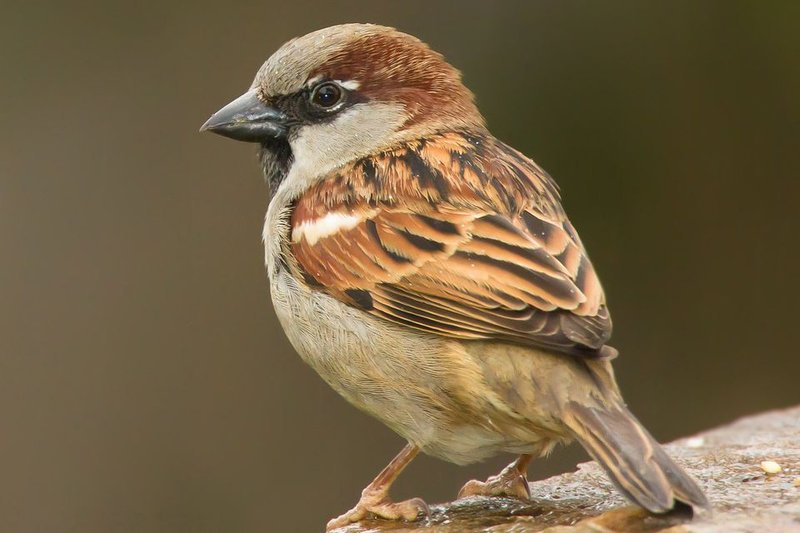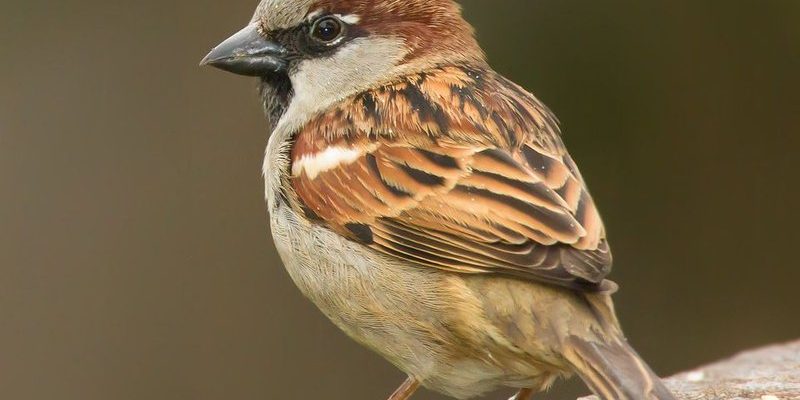
When you think about birds that are common in our neighborhoods, the House Sparrow probably comes to mind first. This little bird is not just a frequent flier in our parks and backyards; it’s also a fascinating creature with a rich history and an adaptable nature. These lively birds have learned to live alongside us, thriving in urban environments all over the world. If you’ve ever watched them flitting around a picnic or chirping cheerfully in a tree, you’ve witnessed their delightful antics that make them a joy to observe.
You might be wondering what exactly makes the House Sparrow so special. Unlike many other birds, they have a unique ability to adjust to their surroundings, which is partly why they can be found in cities, suburbs, and rural areas alike. Plus, their social behavior and melodious songs create a delightful soundtrack to our everyday lives. Let’s dive deeper into understanding these charming little creatures!
Physical Characteristics
The House Sparrow measures around 6 to 7 inches in length, making it a small to medium-sized bird. It weighs about 0.5 to 1 ounce and has a wingspan of roughly 9 to 12 inches. One of the first things you’ll notice is their distinctive markings. Males sport a striking combination of black, brown, and gray, with a signature black bib under their chin. Females, on the other hand, have a more subdued color palette, primarily featuring sandy brown and tan hues, which help them blend seamlessly into their surroundings, especially when nesting.
Interestingly, the differences between male and female House Sparrows are not just in color. Males tend to be slightly larger and have a more pronounced, chattier song. Their feathers are not only beautiful but also serve a practical purpose, providing insulation and protection against the elements. This ability to adapt their physical traits helps these birds thrive in various environments, from bustling urban spaces to quiet rural areas.
Another fun fact is that House Sparrows have a short, stubby beak that is perfectly suited for their diet, and their strong legs make them agile movers on the ground. This combination of physical attributes allows them to forage effectively for food and navigate their habitats with ease.
Habitat and Range
House Sparrows are incredibly versatile when it comes to their living conditions. You can find them in a variety of places, but they particularly thrive in urban areas where human activity is high. They build their nests in sheltered spots like eaves, ledges, and even in dense shrubs. Their ability to adapt to human presence makes them one of the most successful birds in the world.
These birds are not native to North America; they were introduced in the 19th century. Since then, their population has exploded, allowing them to spread across the continent and beyond. From the crowded streets of New York City to serene gardens in the countryside, the House Sparrow has made itself at home almost everywhere. This extensive range makes them one of the most widely distributed bird species globally.
While they prefer urban settings, House Sparrows are also found in rural areas, particularly near agricultural fields where food is abundant. Their adaptability to different environments is remarkable, ensuring that they can find food and shelter regardless of circumstances.
Diet and Feeding Habits
When it comes to food, House Sparrows are opportunistic feeders, which means they will eat just about anything they can find. Their diet primarily consists of seeds, grains, and fruits, but they are also known to consume insects and scraps of human food when the opportunity arises. This flexibility in diet helps them thrive in a variety of habitats.
In urban settings, you might see House Sparrows scavenging around outdoor eateries or picking at dropped crumbs on the sidewalk. In nature, they forage in fields and gardens, often seen pecking at seeds that fall to the ground. Their short, stout beaks are perfectly engineered for cracking open seeds and grains, which is a big part of their diet.
Interestingly, House Sparrows also have social feeding habits. You’ll often see them foraging in flocks, which helps them keep an eye out for potential predators while maximizing their foraging efficiency. This communal behavior not only keeps them safe but also enhances their chances of finding food.
Reproduction and Lifespan
House Sparrows are monogamous, forming long-lasting pair bonds. They typically breed in the spring and summer months, with the female laying anywhere from 2 to 6 eggs per clutch. These eggs are usually light blue or greenish in color with speckles. The female does most of the incubation, which lasts about 10 to 14 days. Once the chicks hatch, both parents are involved in feeding them, which is quite remarkable.
After about 2 weeks, the fledglings leave the nest, but they stay in the vicinity, learning how to find food and avoid danger. It’s common to see young sparrows being fed by their parents for a few more weeks as they adjust to their newfound independence. This supportive family structure helps ensure that the next generation is well-prepared to navigate the world.
As for their lifespan, House Sparrows can live up to 3 to 5 years in the wild, although some may survive longer depending on environmental conditions and predation. The key to their endurance lies in their adaptability and social behaviors, which keep them thriving even in challenging situations.
Behavioral Traits
House Sparrows are known for their lively and engaging behaviors. They are social birds that often interact with one another through chirps and chattering. You’ll notice them hopping around in groups, singing their cheerful songs as they communicate with their friends. Their social nature makes them fascinating to watch, especially during feeding times or when they’re building nests.
One striking behavior is their tendency to monopolize bird feeders. They can be quite assertive, often scaring off other birds to claim their space. This can be frustrating for those hoping to attract a variety of birds to their backyard, but it’s just part of their nature. Their keen intelligence also allows them to figure out how to access food sources that may be out of reach for other birds.
Another interesting aspect of their behavior is their adaptability to human activities. House Sparrows often take advantage of our discarded food, making them champions of survival. Whether it’s foraging from picnic leftovers or nesting in human-built structures, these birds showcase a remarkable ability to thrive alongside us.
Conservation Status
Currently, the House Sparrow is not considered endangered. In fact, their population is stable and even increasing in many areas due to their adaptability and successful reproduction. However, there are concerns about local declines in certain regions, primarily due to habitat loss and changes in agricultural practices. As cities evolve, the loss of green spaces can impact their nesting sites and food sources.
Efforts to understand and protect urban habitats can help maintain healthy House Sparrow populations. Conservationists encourage practices that promote biodiversity in cities, like creating green roofs, planting native trees, and providing nesting boxes. These measures can help ensure that House Sparrows continue to thrive alongside us.
By becoming more aware of the environmental factors that affect House Sparrows, we can appreciate their role in our ecosystems. Observing their behaviors and understanding their needs can foster a greater appreciation for these resilient birds in our everyday lives.
Interesting Facts About House Sparrows
| Common Name: | House Sparrow |
| Scientific Name: | Passer domesticus |
| Size: | 6-7 inches (15-18 cm) |
| Wingspan: | 9-12 inches (22-30 cm) |
| Weight: | 0.5-1 ounce (15-30 grams) |
| Lifespan: | 3-5 years in the wild |
| Diet: | Seeds, grains, fruits, insects |
| Habitat: | Urban, suburban, and rural areas |
FAQ
Why are House Sparrows so common in urban areas?
House Sparrows thrive in urban environments due to their ability to adapt to human activity. They find ample food sources, including scraps from our meals and seeds from sidewalk cafes. Their nesting habits are also suited to city life, where they can make homes in nooks and crannies of buildings. This close relationship with humans has allowed them to flourish in environments that may be restrictive for other bird species.
How can I attract House Sparrows to my garden?
If you want to attract House Sparrows, consider providing bird feeders filled with seeds, particularly millet and sunflower seeds. They also appreciate open areas where they can forage for food on the ground. Planting shrubs and trees that offer nesting sites is another great way to invite them into your garden. Remember, the more welcoming your space, the more likely these charming birds will come to visit!
Are House Sparrows harmful to native bird species?
House Sparrows can sometimes outcompete native birds for food and nesting sites due to their aggressive behavior and adaptability. This can pose challenges for smaller, less aggressive bird species. Conservationists often monitor their populations in certain areas to ensure that local ecosystems remain balanced while promoting awareness about the need for biodiversity in our gardens and parks.
What do House Sparrows eat in the wild?
In their natural habitats, House Sparrows primarily feed on seeds, grains, and fruits. They are also known to eat insects, especially during the breeding season when they need additional protein for their chicks. This varied diet helps them thrive in different environments, from urban settings to rural farmlands.
What is the purpose of a House Sparrow’s song?
The song of a House Sparrow serves multiple purposes, from attracting a mate to establishing territory. Males are known for their melodious chirping, which can help them communicate their presence to females and warn rivals to stay away. This vocalization plays a crucial role in their social interactions and breeding success.
How do House Sparrows build their nests?
House Sparrows are skilled nest builders. They often use grass, feathers, paper, and even plastic materials to create secure nests. Typically, the female chooses the nesting site and gathers materials, weaving them together to form a cozy home. These nests can be found in sheltered spots like eaves, tree branches, and bird boxes, providing a safe place for the eggs and chicks.
Can I feed House Sparrows in winter?
Yes, feeding House Sparrows in winter can be beneficial, especially during harsh weather when food is scarce. Offering bird feeders with seeds and grains can help them survive and thrive. Just make sure the feed is fresh and doesn’t contain harmful ingredients. Providing water sources during freezing temperatures can also support their survival.
Do House Sparrows migrate?
House Sparrows are generally non-migratory birds, which means they tend to stay in the same area year-round. However, in colder climates, some may move to more temperate regions during harsh winters. Their adaptability to human habitats allows them to find sufficient food and shelter, reducing the need to migrate for survival.
What predators do House Sparrows have?
House Sparrows face various predators, including cats, hawks, and larger birds like crows. Their social behavior can help them detect these threats, as they tend to forage and roost in groups. However, their small size makes them vulnerable, which is why their ability to swiftly flee to cover is essential for their survival.
How can I help House Sparrows in my local area?
You can help House Sparrows by creating suitable habitats in your garden, such as planting native plants and installing nesting boxes. Avoid using pesticides that can harm their food sources. Participating in local conservation efforts to protect urban green spaces and advocate for biodiversity can also support their populations. Every small effort counts in helping these charming birds thrive!

